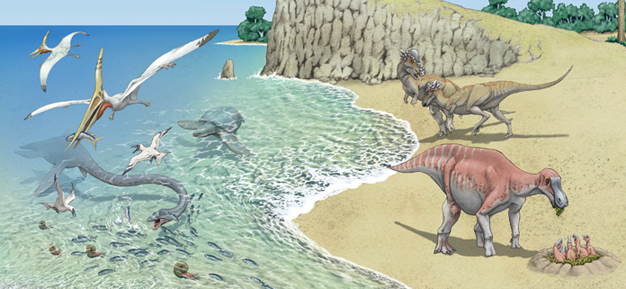
トップページ(top page)> 中生代白亜紀後期の世界(The world of Late Cretaceous)
|
中生代・白亜紀後期の世界
( Late Cretaceous) 9900万〜6500万年前 (99 million years〜65 million years ago) |
|
(The former age) 前の時代へ←■ →次の時代へ (The next age) |
|
世界の様子 Environment |
The Late Cretaceous was a period with warm climate and high eustatic sea level.
And oxygen became abundant through the Mesozoic Era.
A single supercontinent separated into seven continents and
a wide variety of plants and animals appeared on each continents.
|
生物 Life |

卵の孵化を助ける高い気温が爬虫類を繁栄させ、恐竜は支配的地位を占めていた。
The reptiles flourished in the high temperature to help hatching eggs
最初の鳥類が現れたのもこの頃。
哺乳類も影ながら繁栄しており、最初の有胎盤類も登場する。
被子植物は花をつけるようになり、昆虫とともに栄える。
海では魚竜が絶滅し、
6500万年前の白亜紀の大絶滅では首長竜も恐竜とともに姿を消した。
and the dinosaurs dominated.
Birds (Aves) first appeared during this period.
During this time, Mammals also flourished and
Placental mammals first appeared during this period.
Angiosperms that came to flower flourished with insects.
Ichthyosaurs became extinct in the sea and Plesiosauria also died out with
dinosaurs at the K-T extinction event, 65 million years ago.
|
白亜紀( K-T境界)の大量絶滅 Cretaceous–Tertiary (K–T boundary) extinction event |

6500万年前、メキシコ沖に巨大隕石を落ち、急激な気候変動で
It's generally understood that a large meteorite fell on the coast of Mexico
関連ブログ記事>>>
「竜を滅ぼし破壊神シヴァ」
大量絶滅したことが有力。
恐竜やアンモナイトなど生物種の70%が絶滅したといわれている。
恐竜が絶滅したことでよく知られる大量絶滅事件であるが
過去5億年の5度の大量絶滅(ビックファイブ)のなかでもっとも軽症である。
and rapid climate change caused mass extinction 65 million years ago.
It is said that 70% of all species, such as the dinosaurs and ammonites, wiped out in this extinction.
The K-T extinction is best known as the dinosaur extinction
but it was the smallest extinction in the five major mass
extinctions over the last 500 million years, called the Big Five.
| 古生代 | エディアカラ紀 | カンブリア紀 | オルドビス紀 | シルル紀 | デボン紀 | 石炭紀 | ペルム紀 |
|---|---|---|---|---|---|---|---|
| 中生代 | 三畳紀前期 | 三畳紀後期 | ジュラ紀前期 | ジュラ紀後期 | 白亜紀前期 | 白亜紀後期 | |
| 新生代 | 古第三紀 | 新第三紀 | 第四紀 | ||||
| 現在 | 現在 | ||||||
| 未来 | 500万年後 | 5000万年後 | 1億年後 | 2億年後 |
トップページ(top page)> 中生代・白亜紀後期の世界(The world of Late Cretaceous)